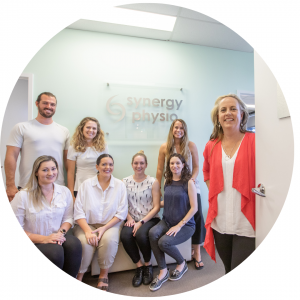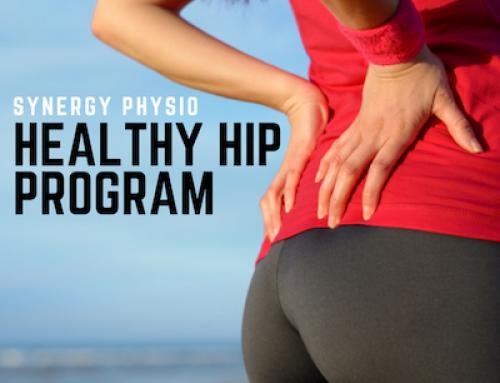As a clinic with expertise in hip pain, it is common for our patients to present to us with a variety of hip conditions. One of these conditions is FAI syndrome and also hip labral tears. Let’s explore what that is and what you can do about it.
What is a labral tear?
Your hip ball and socket joint lies deep in the groin. Everyone has a slightly different shaped ball and different shaped socket- which can explain why some people can sit cross legged easily while other people struggle to put a sock on. The shape of your bones can determine how much movement you have in your hip.
Around the edge of the socket you have a ring of cartilage called a labrum. It’s a bit like a calamari ring around the edge of the socket that creates a buffer of protection around the edge of the socket. A labral tear is simply a fraying or a tear of the edge of that cartilage which can contribute to pain with hip movements such as twisting.
There are many reasons you can get a tear in your labrum. Very rarely is it an acute injury, and more often a slow wear and tear process around the edge of the socket. This can occur with:
- Over stretching the hip, especially if you have a shallow socket
- Postural overload by standing sway and sinking into the front of your hips habitually
- A deep socket or a larger ball shape that contributes to loss of space in the joint. This is also known as FAI.
What is FAI?
The diagnosis of FAI Syndrome or Femoroacetabular Impingement Syndrome is a combination of 3 elements to create that diagnosis.
- There is evidence of a slightly different shaped ball and socket joint on Xray, which results in a restriction of movement in the hip. These findings on an x-ray can include either a deeper socket (known as Pincer Morphology) – or a bigger ball (known as Cam Morphology). Just because you have these findings on x-ray does not mean you have FAI as many people have these boney shapes without any pain at all! But it is one contributor to FAI syndrome.
- As well as having findings on x-ray, to diagnose FAI you also need to have an assessment to determine if your pain is actually caused by your hip joint. Your therapist can perform simple tests to determine if your pain is caused by your bony hip shape. Not all pain in the hip region is from the hip! Sometimes there can be lumbar referral, abdominal problems or adductor strains that can all contribute to pain.
- Symptomatic pain with hip activities, if the pain in your groin and hip joint occurs with hip activities such as deep squats, hip movement or actions involving load through the hip, it is also the third element that is required to diagnose FAI.
So FAI is not detected just on an x-ray, an x-ray will only show the shape of your bones. FAI is diagnosed as a combination of x-ray findings of an altered hip joint shape, plus hip pain with hip activities such as twisting, running, getting in and out of a chair or deep squats, as well as a physio assessment to determine if your pain is actually caused by your hip joint.
What to do about it?
What to do about hip labral tears and FAI will always be determined by the specific cause of your symptoms, which can be different for everyone. You can not change the shape of your bones which is why stretching is often unhelpful. Watch this video here to understand.
However there are many factors that can be addressed that all can add to hip pain. These factors can include:
- Your hip strength- specific tailored strengthening exercises can help manage symptoms.
- Your hip stability- keeping the ball centred and stable within the socket is important, especially if you have a shallow socket or hypermobility
- Your posture. Check out our standing postural tips here.
- Outside the square problems adding to hip load including stiff feet, loss of thoracic mobility, core strength and daily hip loading habits.

There are so many factors that can contribute to hip pain, that the solution lies in a thorough individual assessment and treatment plan.
Nichole Hamilton physiotherapist, has a special interest in the management of hip pain and is passionate about patient education and helping you get back to doing the things you love!
Would you like simply to speak to one of our expert physiotherapy team members to find out if we can help you? Contact us on 07 5448 3369 or simply book online!
Treatment?
Physiotherapy treatment can address the underlying causes
of insidious labral tear.
Physiotherapy management can include manual therapy
to SIJ or lumbar spine and will also include a
lumbar-pelvic stability exercise program and functional
gluteal strengthening exercises (pictured)
Physiotherapy tests for
pelvic stability
In many cases, although the labral tear may not heal, addressing these muscle imbalances can offload the hip joint and help resolve the patient’s pain. In some cases where conservative management has been tried for a period of 3 months without improvements, hip arthroscopy is required for removal of the acetabular cartilage tear or flap.
Hip Arthroscopy?
Hip arthroscopy is a day procedure, and most
patients do not need crutches post-operatively.
It is however more complicated than a knee
arthroscopy and rehabilitation following hip
arthroscopy can take between 6 to 12 weeks
before returning to sports and other activities.
Physiotherapy rehabilitation includes core stability
and pelvic-hip strengthening exercises.
Written by Nichole Hamilton Physiotherapist.
Nichole Hamilton is a physiotherapist with a special interest in pelvic and hip dysfunction. She works at both Northern Sports Physio and also runs her own clinic, Synergy Physio at Peregian Beach (www.synergyphysio.com.au). Nichole also runs workshops for physiotherapists alongside Dr Michael O’Sullivan, teaching the post-operative protocol and management of patients following hip arthroscopy.


Leave A Comment